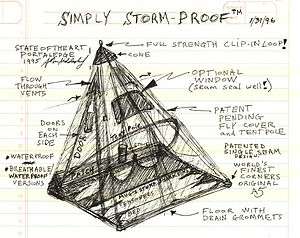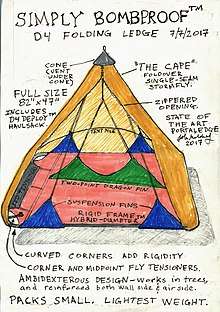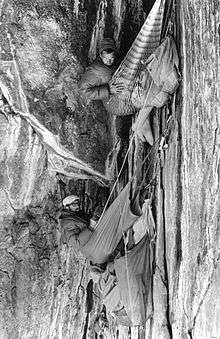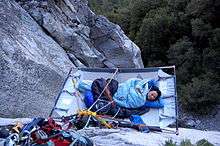Portaledge




A portaledge is a deployable hanging tent system designed for rock climbers who spend multiple days and nights on a big wall climb. An assembled portaledge is a fabric-covered platform surrounded by a metal frame that hangs from a single point and has adjustable suspension straps. A separate cover, called a stormfly, covers the entire system in the event of bad weather.
History
1980–1986
The first portaledges used in Yosemite were non-collapsible cots purloined from Housekeeping Camp, a Yosemite Valley campground that featured primitive metal framed bunks for the campers. These heavy cots were used on multi-day climbs on granite monoliths like El Capitan, and then sometimes tossed off the summit for later retrieval. Mike Graham is credited with the first collapsible portaledge models available for retail purchase under the name of his company, Gramicci Products based in Ventura, California. The Gramicci Portaledge appeared in the very early 1980s and revolutionized multiday big wall comfort. There were a few minor manufacturers that also dabbled in portaledge design in the early 1980s but could not get any traction in this niche market and soon faded from sight. In late 1984 a small California based company called Fish Products started to manufacture one person single portaledges, designed by Russ Walling, the company founder. Fish Products is still manufacturing these portaledges some 25 years later. Other early Portaledge manufacturers were Fig, Lowe (never commercially available), and C&S Engineering.
1986–1998
In 1986, A5 Adventures was founded, headed up by Stanford-trained mechanical engineer John Middendorf who was the chief designer and founder. Previously, Middendorf and his companions Steve Bosque and Mike Corbett had nearly died due to portaledge failure during a three-day storm on the 2000 foot South Face of Half Dome, prompting Middendorf to redesign the modern portaledge.[1] A5 portaledges were constructed of highly weatherproof fabrics and engineered to be structurally stable and strong. Three models were produced: the A5 Single, the A5 Alpine Double, and the A5 Cliff Cabana. The A5 portaledges were the first portaledges that could withstand the severe weather conditions in remote areas such as the Himalayas and the Karakorum, enabling climbers to expand their horizons to the largest rock faces in the world. Middendorf himself used the A5 portaledges on some of the hardest and remote big walls of the world, including the first ascent of The Grand Voyage on the Great Trango Tower in 1992, the longest vertical big wall (1350m) in the world. The A5 Portaledge was sold worldwide and was featured in Abitare, an Italian design magazine.
1998–2016
The assets of A5 Adventures, including the A5 portaledge, were acquired by The North Face (TNF) in 1998. Middendorf continued to steer the product for an additional two years at TNF before moving on to other pursuits outside of the climbing industry. The A5 Portaledge designs were subsequently transferred to Black Diamond Equipment of Salt Lake City, Utah, who continue to produce the A5 designs with many added features. As of 2016, there were four major commercial suppliers of portaledges, making the following popular models:
- Black Diamond Single (81" x 31.5", 21.7 pounds with fly, modified clone of the A5 Single).
- Black Diamond Double (84" x 51", 28.4 pounds with fly and spreader bar, modified clone of the A5 Cliff Cabana).
- Runout Customs Double (75" x 42.25", 15 pounds with fly and haulsack, clone of the A5 Alpine Double).
- Metolius Single (84" x 30", 18.5 pounds with fly, haulsack, similar to the A5 block corner design.).
- Metolius Double (84" x 45", 21.5 pounds with fly, haulsack and spreader bar, similar to A5 design).
- Fish Single/Double (77" x 42", 13/16 pounds with fly; rigid corner ledge design, steel frame).
2017
In 2017, John Middendorf introduced a new portaledge design, called the D4 Portaledge (82" x 47", 16.5 pounds with haulsack, fly, and flypole). Instead of block corners, which has been the de facto standard since they were first introduced, the new D4 Portaledge has rounded curved tubing corners, which offer more rigidity and are lighter than the traditional block corners. The D4 portaledge brings many more innovations, including a newly engineered hybrid diameter tube design, which provides strength and rigidity without the need for a spreader bar, a new integrated haulsack/deployment system, and a completely simple but new concept for the stormfly--a single vertical zipped opening which enables the quickest deployment while also allowing full opening between storms. The D4 also packs smaller (29” x 10”) than previous designs of portaledges.
References
- ↑ "Rescue on Half Dome". bigwalls.net. Retrieved 2013-04-14.
| Wikimedia Commons has media related to Portaledge. |
External links
- "Jonathan Olivares, History of the Portaledge". Archived from the original on 21 May 2013. Retrieved 13 April 2013.